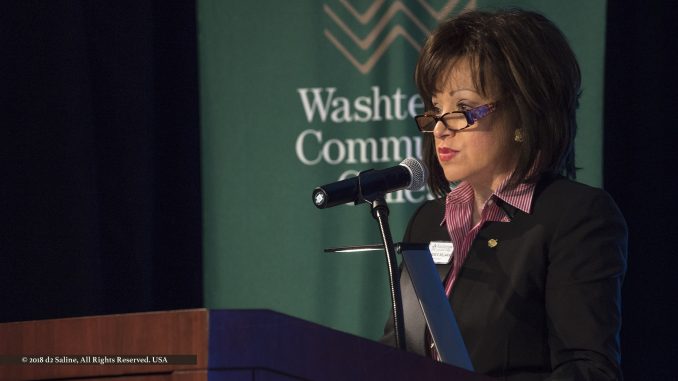
Why is it important?
Part 1 of this special series defined the term “smart cities.” It identified local officials here, by name, who have focused on helping Saline get in front of this concept. It concluded with the bold assertion that “Smart cities are not a question of If? but, rather, When?” [1,2,3]
But now it’s important to take a step back and explain the needs served, problems solved.
Among others, Washtenaw Community College (WCC) sees this as a priority as well. Recent WCC credentials regarding this subject include an office on site at the American Center for Mobility, as Dr Rose B Bellanca, Washtenaw Community College president noted in opening the Smart Cities symposium earlier this month. [4,5,6]
“Our mission is to support economic development by providing a trained workforce, which includes upskilling incumbent workers,” she began. “We are here to support the majority of stakeholders who do not recognize the changes they are already a part of.”
With her subsequent introduction of Dr Toni C Antonucci of the University of Michigan Institute for Social Research, the WCC conference began to provide the context that answers the Why? question above here.
“Technology has to meet the needs of people. We need to know what the population will look like when it arrives,” Dr Antonucci asserted — keenly aware of the implied chicken-versus-egg imponderable. [7,8]
Significantly, she projected a need for cities to accomodate increasingly older populations and individuals now experiencing chronic health challenges (disabilities) at younger average ages. Emerging multi-generational home lives will add to the complexity of cities dealing with population concentration impacts on housing and mobility. Smart city adaptations must support their healthcare, productivity, and safety infrastructure needs.
WCC Smart Cities bookended the academic take on this from Dr Antonucci with a closing panel that included smart city early adopters from Ann Arbor, Michigan and Seat Pleasant, Maryland.
Seat Pleasant Mayor Eugene W Grant summarized his experience in a deployed smart city by saying such initiatives “aren’t just about the digital component. They’re about using digital to solve challenges, to improve our quality of life as human beings.” [9,10]
“These aren’t problems we can ‘build’ ourselves out of,” added Dr James R Sayer, Director of the University of Michigan Transportation Research Institute. [11]
Craig Hupy, Public Service Area Administrator for the City of Ann Arbor put numbers to this. “There are 80,000 commuters in and out of Ann Arbor each day. We’re not getting more roads. So we must move those vehicles more effectively, or avoid having so many of those vehicles.”
Dr Sayer then summarized the challenge by posing this question: “How do you retain the characteristics of a community and still grow?”
“That’s why we need smart cities,” Mr Hupy replied.
References
- “It’s Important to Understand What Being a ‘Smart City’ Means to Saline, Part 1” Dell Deaton (April 12, 2018) Saline Journal.
- “It’s Important to Understand What Being a ‘Smart City’ Means to Saline, Part 3” Dell Deaton (April 20, 2018) Saline Journal.
- “It’s Important to Understand What Being a ‘Smart City’ Means to Saline, Part 4” Dell Deaton (April 27, 2018) Saline Journal.
- “WCC brings workforce development to American Center for Mobility” Richard Rezier (May 30, 2017) Washtenaw Community College News & Events.
- American Center for Mobility (home page).
- “Smart Cities: A Connected Way Forward” (April 6, 2018) Washtenaw Community College.
- University of Michigan Institute for Social Research (home page).
- “Did You Know (Officially updated for 2018)” Free Working Tricks (September 3, 2016) YouTube.
- “Smart City” Seat Pleasant, Maryland.
- “Smart City Project” Seat Pleasant, Maryland.
- University of Michigan Transportation Research Institute (home page).
Hashtag
#wccsmartcities



